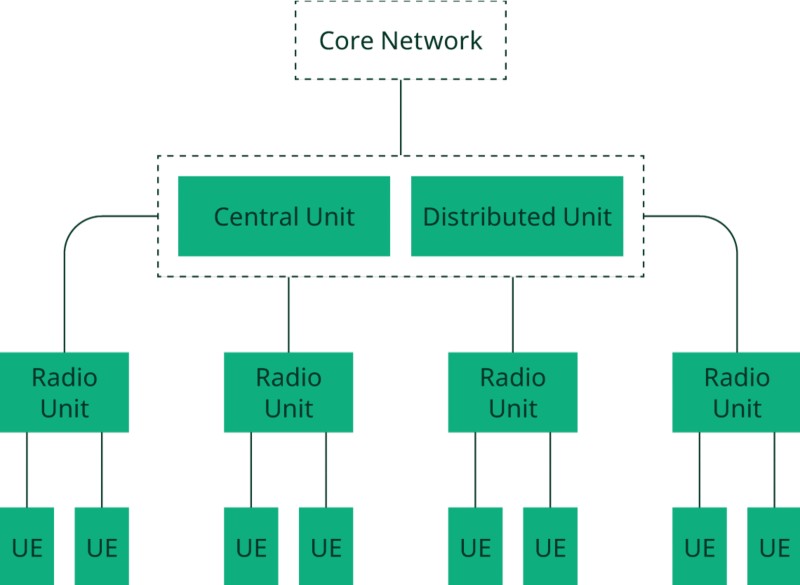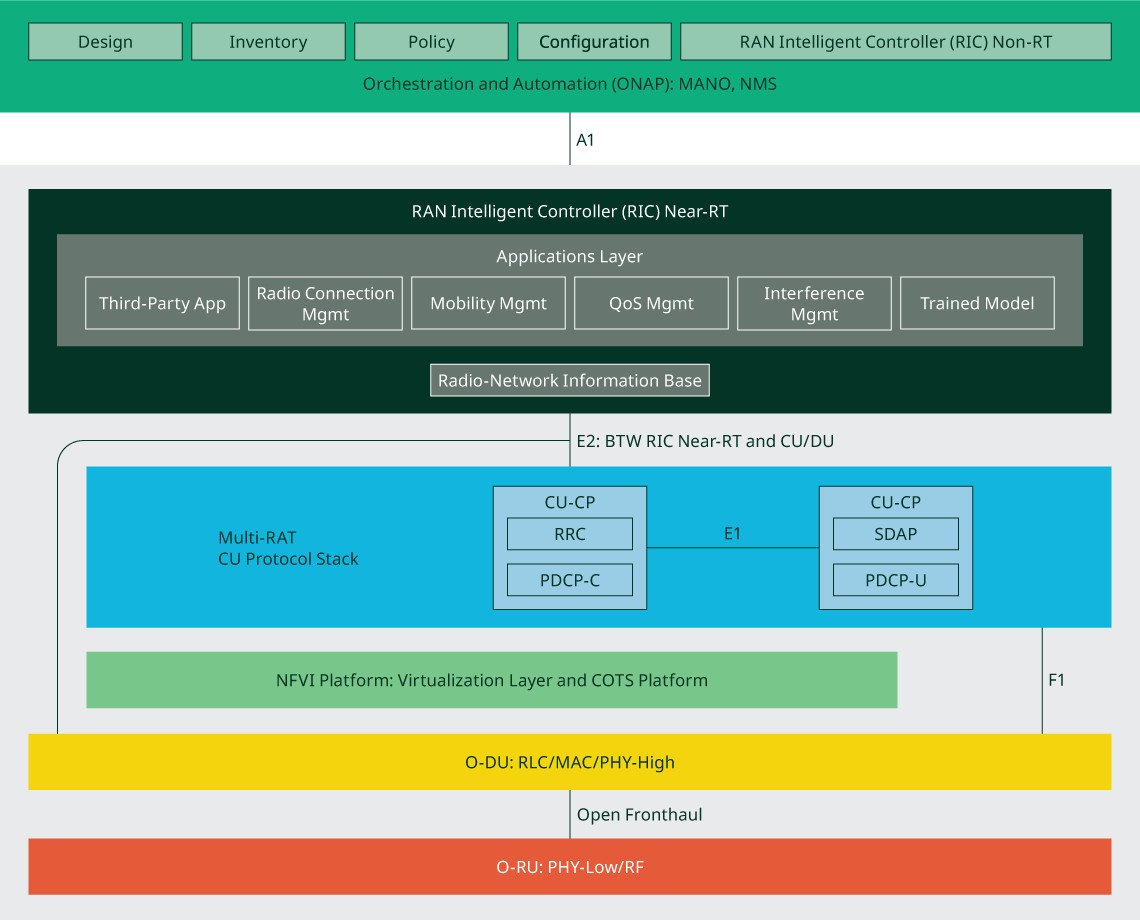Navigating the Complexities of Radio Unit (RU) Test in RAN Wireless Networks
Overview
Receive a comprehensive overview of the critical components and considerations involved in testing radio units (RU) within radio access networks (RAN). Learn the significance of the RU in wireless communication, followed by an exploration of different RAN functional splits and their impact on RU operations. Get key information on addressing the challenges posed by various configurations, test points, and functional splits.
Contents
- The Crucial Role of Radio Units (RU) in Radio Access Networks (RAN)
- RAN Functional Splits
- Importance of the RU and RU Test Considerations
- NI RU Test Solutions
The Crucial Role of Radio Units (RU) in Radio Access Networks (RAN)
The radio access network (RAN) describes the communications infrastructure for connecting mobile phones to the core network. It coordinates the resources and data of the network, enabling connections to other cellphones, devices, and data connectivity and is the backbone of the way we communicate globally today.
There are many variations on the RAN, and depending on the cellular generation (3G, 4G, 4G LTE, 5G NR), region, frequency of operation, and many other factors; the exact composition and components of the RAN can vary greatly.
One of these RAN components, the radio unit (RU), is a crucial component to wireless communication through the RAN as it is responsible for transmitting and receiving RF signals from user equipment (UE) and relaying this to other components of the base station. Like the RAN itself, it similarly varies depending on the context of the application. In this white paper, we will cover some different permutations of the RAN, how this affects the operation and composition of the RU, and how test of the RU is impacted as a result.
RAN Functional Splits
The RAN, and wireless network infrastructure, has evolved greatly over the decades since its inception. Starting with the early stages of 5G, cellular infrastructure has transitioned from a single (often called monolithic) base station into various base station components with split functions.
The Role of O-RAN in Modern Cellular Networks
One such permutation of the split base station is the O-RAN architecture. The O-RAN (7.2x) fronthaul split, as defined in 3GPP Rel-15, separates the RAN into three main components, the radio unit (RU), centralized unit (CU) and distributed unit (DU). This design allows for flexibility in implementation, load management, performance enhancements, and the ability to use components from various vendors, as interfaces are more open and accessible. A diagram of the O-RAN architecture can be seen in Figure 1.
Figure 1: O-RAN Alliance Reference Architecture (Source: O-RAN white paper)
Learn more about the O-RAN architecture
While O-RAN is new and gaining traction regionally with many benefits of traditional RANs, it will not be the only type of cellular infrastructure deployment over the coming decades. When considering the existing infrastructure, demand for cellular connectivity, cost of implementation, and regulatory constraints, among other things, the cellular infrastructure deployed will depend on the specific region and use case.
As a result, different RUs will be required depending on the exact base station variation of a particular scenario. This variability means that RUs with different architectures, functional splits, and proprietary or open IP will continue to need to be manufactured and tested.
| Split | RU Functions | DU/CU Functions | Test Considerations |
|---|---|---|---|
| 8 | RF | PHY, MAC, RLC, PDCP |
|
| 7-2* | RF, low PHY (ADC/DAC, FFT/iFFT, digital beamforming, pre-coding) | High PHY, MAC RLC, PDCP |
|
| 7-3 | RF, low PHY (ADC/DAC, FFT/iFFT, digital beamforming, pre-coding, modulation) | High PHY, MAC RLC, PDCP |
|
| 6 | RF, PHY | MAC, RLC, PDCP |
|
| 2 | Combined RU/DU (All RF, PHY, MAC, RLC) | PDCP |
|
*7-2x functional split can vary
Table 1: Select RAN RU Functional Splits
How Functional Splits Influence RU Testing
While the exact RAN split can vary, there are eight primary ways the RU connects to higher-level components in the base station. The type of functional split implemented dictates what functions are contained on the RU. This decision, in turn, determines what must be tested during the development process.
Figure 2: RAN Functional Splits
Importance of the RU and RU Test Considerations
The RU is a crucial component in any cellular network base station. Responsible for receiving modulated signals from UEs, the RU connects the rest of the base station and core network to end users. It also connects many UEs simultaneously to a single base station. This function means it has the most components along with a considerable number of test points, as many RUs have multiple antennas.

Figure 3: Diagram of RU with Multiple Test Ports
Challenges in RU Production Test
The consequence of these functions means that the RU often presents unique challenges in production test:
- Configurability—RUs can come in many different configurations, with multiple antennas, channels, and duplexed layouts. In addition, there are different RAN functional splits that can require differing test requirements.
- Cost—The functions of the RU mean the test systems required are often complex and thus more costly than test equipment for other kinds of DUTs. Minimizing total test cost through factors such as scalability, channel density, and development time is crucial to success.
- Test time—Being the most numerous components with the most test ports means even a small increase in test time has a compound effect with the quantity of tests that are required.
Efficient Test Strategies for Radio Units
Proper switching, test sequencing, and parallelism, and a focus on scalable and reusable software, are all necessary to ensure efficient and easily configurable test cases and can help minimize the previously highlighted challenges.
Perhaps the greatest variation in the test requirements of an RU involves the functional split. Since the functional split determines what functions are on the RU as opposed to other base station components, some fundamental test functions such as DUT control, DU emulation, and digital interfacing vary greatly and can influence test cost and time for both development and test.
The key to accounting for these fundamental changes in test is an open and versatile test platform. It is difficult to find a test system capable of adapting to varying RAN configurations, especially as different regions will progress to new kinds of wireless infrastructure at different times and at different rates. Built on a PXI platform, and with software at its core, NI’s test and measurement solutions for base stations RUs are well positioned to meet these demands.
NI RU Test Solutions
NI’s combination of versatile hardware and software can help deliver effective RU production test solutions. By setting a high-level starting point for configuring tailored test solutions, the NI test platform balances customized test requirements with fast development and bring-up times for a solution that is scalable, customizable, and cost-effective with minimal integration and development.
NI's hardware solutions for RU test are built on the modular PXI platform, featuring the PXI Vector Signal Transceiver (VST). VSTs combine a vector signal analyzer (VSA), vector signal generator (VSG), user-programmable FPGA, and high-speed digital interfaces, making them well-suited for comprehensive RF test applications. Notable models include the PXIe-5842, which offers frequency coverage up to 26.5 GHz and 4 GHz of instantaneous bandwidth, and the PXIe-5841, a cost-effective option with frequency coverage up to 6 GHz. These VSTs are designed to handle the demanding requirements of RU production test, offering scalability, high performance, and the ability to accommodate various cellular standards from legacy to 5G.
For software, RFmx provides a powerful and intuitive interface for RF measurement and automation. RFmx supports a wide range of applications, from general-purpose RF measurements to standard-specific configurations for 5G NR, Wi-Fi 7, and more. It offers features such as interactive Soft Front Panels for quick measurement setups, advanced programming APIs for automated testing, and compatibility with NI's InstrumentStudio™ software for a comprehensive test bench experience. RFmx ensures efficient test plan execution with multi-threaded parallel measurement capabilities, making it an ideal choice for optimizing test speed, accuracy, and development time in RU production environments.

